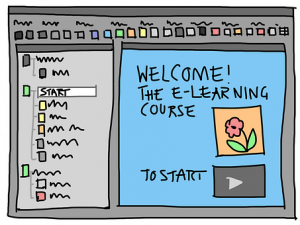Technology is rapidly developing, including advances in e Learning, which continue to adapt to market demands. Gone are the days when always preparing locations with busy schedules and unnecessary trips. If you are just starting out on your e-learning project, you may encounter various difficulties while trying to explore your preferred learning method. To take care of you, here are some of the types of e-learning that you will find near the definition, as well as their pros and cons.

Types of e-learning
1. Improve e-learning
E-learning remains one of the most experienced versions of online learning. It refers to a learning cycle that uses ordinary constructs to convey data to students. All students receive data similar to that provided by the teacher. Because teaching materials depend on the teacher, e-learning remains inflexible and does not adjust to student trends. This type is best for conditions where students have comparative schedules and skills. For example, traditional school assessment classes that require eLearning can improve this type of design.
dominate
E-learning still works best when training is based on a regular graduation plan that includes a permanent education program.
It will be much easier and longer for trainers to perform universal procedures with less variation.
loss
Because of its uniqueness, it is difficult to adapt to today’s different e-learning needs.
The usual preparation approach also requires certified components.
This is a common type of discovery that neglects to think about each student’s individual learning opportunities.
2. Universal e-learning
Universal e-learning is a different type of online learning. Contrary to the main result, universal eLearning has students’ adaptability as a convergence point. Here, all learning materials are adapted to your learning tendencies. It focuses on perspectives such as individual abilities, skills, and performance. Using these factors to meet your adjustment needs can be changed because you feel left out or changed based on the ultimate goal of the course. Diverse e-learning works best when students want to learn at their own pace. However, you need to be very focused on keeping up with the universal electronic learning pace.
Professional
Universal training is customizable and allows you to take courses based on your individual needs.
loss
Since universal eLearning is customized for each sub-study, teachers managing it cannot attempt to implement the eLearning plan in bulk at scale.
3. Non-competitive e-learning
With simultaneous e-learning, students can concentrate freely on different areas. Here students can concentrate individually depending on the schedule. This can include content created by customers. For example, instead of various decision tests, students could present videos demonstrating their newly acquired skills.
Professional
This type of e-learning takes into account the requirement for a customizable individual schedule that allows for both personalized and individual training time.
Students from different topographical areas also benefit from similar learning tools available to their peers.
loss
Simultaneous e-learning can be annoying and gradually expand its impact on neglect if you take it into account. Some students need consistent assessment and contact with their peers to keep up with the pace required here.
4. Intuitive e-learning
With intuitive e-learning, teachers and students can broadcast smoothly so that both players can make changes to the learning material according to their wishes. Open correspondence management also takes into account better collaboration, leading to better training cycles for inquiries. Intuitive e-learning performs admirably in a limited, inherent climate that allows for adaptability.
Professional
The open nature of the correspondence leads to a uniform training cycle for students and teachers. The open correspondence further increases learning autonomy for students because you have the words in the learning cycle.
loss
Not suitable for large numbers of online students as it can create chaos (especially for teachers).
5. Individual e-learning
Individual e-learning refers to the training of students who study alone and without correspondence.
dominate
E-learning specifically helps students learn near home by, for example, linking objective achievement rather than relying on the norms of their teachers and peers.
loss
This limits all types of correspondence and leads to data protection. Here all you have to do is adjust and achieve your goals without the help of others. Due to a lack of follow-up, individual e-learning can easily work in very specific circumstances where students are highly energetic and gifted.
Read Also: Benefits of Employers Training from Company Training
6. Community-oriented e-learning
A community-oriented collaborative e-learning centre where students can work together. The learning material and objectives depend on the combined efforts of all students to complete the course. In pursuing this type of exercise, you need to consider the strengths and weaknesses of both you and your peers.
Genius
Correspondence and collaboration between students continue a corner that is often fed up with web-based learning. In addition, basic considerations are made by considering the different perspectives of students during the learning cycle. Due to its community plan, it can work really well with students from various foundations and communities. This is an interesting learning tool that will help build awareness and harmony between people from different congregations.
loss
E-learning in society can cause some students to become too dependent. Because of the reliance on collaborative efforts, many students are able to sit back and let others do the work for them. This may appear unsolicited to certain students because they rely on the remaining weights of each setting. Each e-learning cycle is suitable for a variety of individual conditions and tendencies. Before agreeing to any decision, find out what is best for you and your goals.





